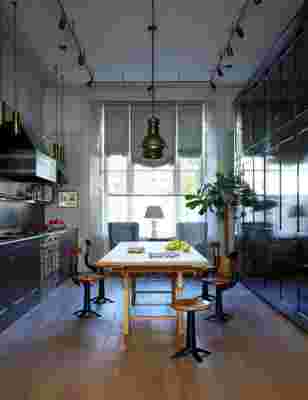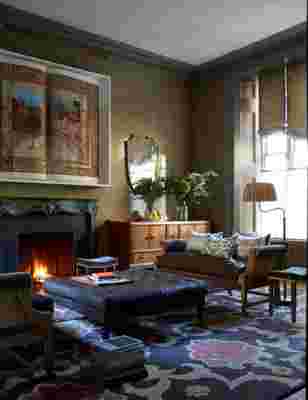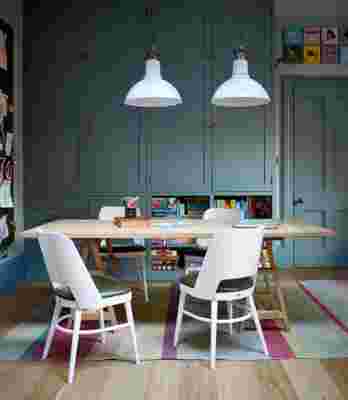Some people make art purchases based solely on aesthetic preference. Others let their wealth portfolios dictate their acquisitions. But for the romantic among us—yes, some of those do still exist—collecting is an exercise in social awareness and a declaration of values. If the walls of one family home in London’s posh Notting Hill neighborhood could talk, they’d weave a subtle yet distinct story about the importance of recognizing under-represented voices in the art world and beyond—and of turning hot-button issues into commonplace dinner conversations.
“We feel strongly that art provides a meaningful context in which to raise a family,” says the homeowner, who with his wife has amassed a collection that speaks to their diverse backgrounds (he is Canadian of Indian heritage, she is American of Burmese descent) and includes works by established and up-and-coming talents: British artist and Turner Prize finalist Lynette Yiadom-Boakye’s Trait hangs in the family room; Pakistani-American visual artist Shahzia Sikander’s portrait of anti-colonial provocateur Frantz Fanon welcomes guests in the entry hall. “We love things that are beautiful, but we look more for work that serves as deep commentary on what matters: representation and inclusion. These are important now, but they have always been important.”

Plain English cabinetry painted in Pure & Original ’s Aubergine and Ristretto create a moody focal point that’s offset by zellige Emery & Cie tiles in the kitchen. The pendant lights by Felix Lighting hang above a bespoke table by Matthew Cox and against a backdrop of Farrow & Ball ’s Elephant’s Breath, Dove Tale, and Dimity on the respective walls, woodwork, and ceiling.

In the reception room, mirrors by Fiona McDonald and a lacquer wall finish by Will Foster Studios add luster to cozy leather sofas by Howe , patterned cushions by Yastik , and vintage sideboards from Miles Griffiths Antiques . An antique table lamp from Howe, two coronation stools in original upholstery, and a Lassco French revival fireplace complete the scene. “It becomes even more beautiful with each viewing,” says the homeowner of the Shahzia Sikander artwork that hangs above the fireplace.
That doesn’t mean the pieces on display don’t add to the aesthetic beauty of the home, which comprises three consolidated units in a converted Regency-era house in Notting Hill that has been thoughtfully renovated by British designer Nicola Harding of London’s Harding & Read. She recast the space, removing walls to create a sprawling kitchen and dining area at the front of the home—to accommodate her clients’ frequent dinner parties, late-night sing-alongs, and after-school playdates (the homeowners have two daughters, ages 7 and 10)—as well as a family room, where she extended the ceiling to reveal an original wood beam that adds nice contrast to a minimalist metal fireplace. A staircase connecting the two levels and custom built-in cabinetry are new additions; cornices and ceiling molding are not. The changes establish a framework for the juxtaposition of past and present, old and new, traditional English culture and global influences. “We wanted an eclectic home that respected the architecture of the space but celebrated the dissonance of our current lives there, and Nicola listened and brought that to her work,” says the homeowner.
Much of that curated aesthetic was the result of careful research into Regency-appropriate fabrics, paint colors (Farrow & Ball provided the bulk of the finishes), and furniture styles—and the judicious work of local artisans like bespoke furniture maker Christopher Howe, whose celebrated Pimlico Road shop created many of the upholstered armchairs on display, and Matthew Cox, who made the rustic trestle table that dominates the kitchen, as well as the crafting table that appears in the family room. Handloomed custom rugs came through Christine Van Der Hurd’s shop nearby on Portobello Road. “We wanted things to feel as though they’ve always been there,” says Harding of the balance.

The ultimate resource for design industry professionals, brought to you by the editors of Architectural Digest
But it is the homeowners’ art that brings the space to life, weaving a vibrant tapestry that serves as shorthand for the family’s shared experiences and is tied to their collective consciousness. “The way most people have memories associated with that spill or that scratch, we have them for the different works that appear throughout the house,” the husband says. “The artists themselves have meaningful things to say that feel true to us, but there’s also something very organic about the way people react in different ways at different times to viewing the pieces. It makes for lots of interesting conversations.” It also makes for a home that wears its duality well, honoring its sense of history and projecting a bright outlook toward its future.
